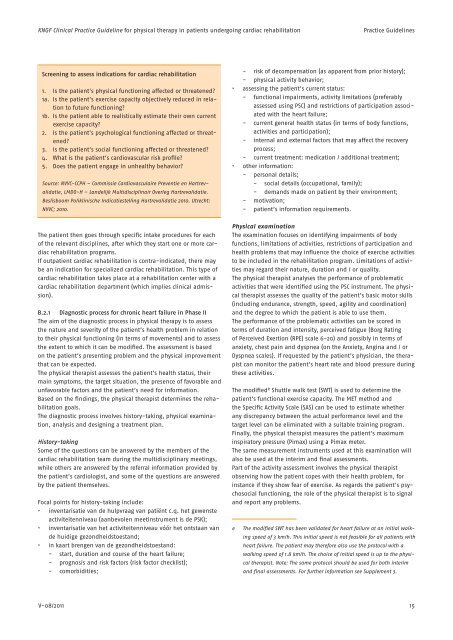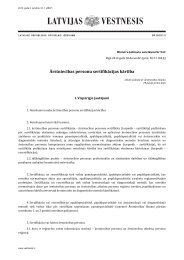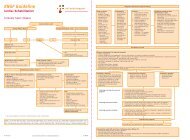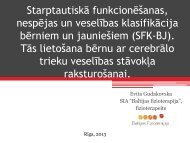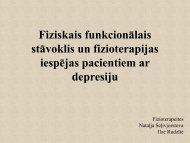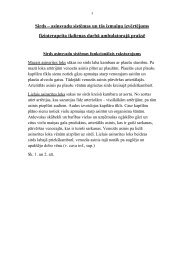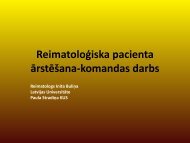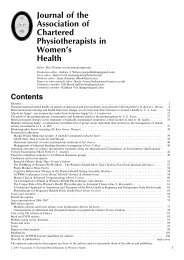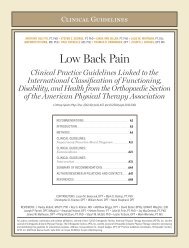KNGF Guideline Cardiac rehabilitation
KNGF Guideline Cardiac rehabilitation
KNGF Guideline Cardiac rehabilitation
Create successful ePaper yourself
Turn your PDF publications into a flip-book with our unique Google optimized e-Paper software.
<strong>KNGF</strong> Clinical Practice <strong>Guideline</strong> for physical therapy in patients undergoing cardiac <strong>rehabilitation</strong><br />
Practice <strong>Guideline</strong>s<br />
Screening to assess indications for cardiac <strong>rehabilitation</strong><br />
1. Is the patient’s physical functioning affected or threatened?<br />
1a. Is the patient’s exercise capacity objectively reduced in relation<br />
to future functioning?<br />
1b. Is the patient able to realistically estimate their own current<br />
exercise capacity?<br />
2. Is the patient’s psychological functioning affected or threatened?<br />
3. Is the patient’s social functioning affected or threatened?<br />
4. What is the patient’s cardiovascular risk profile?<br />
5. Does the patient engage in unhealthy behavior?<br />
Source: NVVC-CCPH – Commissie Cardiovasculaire Preventie en Hartrevalidatie,<br />
LMDO-H – Landelijk Multidisciplinair Overleg Hartrevalidatie.<br />
Beslisboom Poliklinische Indicatiestelling Hartrevalidatie 2010. Utrecht:<br />
NVVC; 2010.<br />
- risk of decompensation (as apparent from prior history);<br />
- physical activity behavior;<br />
• assessing the patient’s current status:<br />
- functional impairments, activity limitations (preferably<br />
assessed using PSC) and restrictions of participation associated<br />
with the heart failure;<br />
- current general health status (in terms of body functions,<br />
activities and participation);<br />
- internal and external factors that may affect the recovery<br />
process;<br />
- current treatment: medication / additional treatment;<br />
• other information:<br />
- personal details;<br />
- social details (occupational, family);<br />
- demands made on patient by their environment;<br />
- motivation;<br />
- patient’s information requirements.<br />
The patient then goes through specific intake procedures for each<br />
of the relevant disciplines, after which they start one or more cardiac<br />
<strong>rehabilitation</strong> programs.<br />
If outpatient cardiac <strong>rehabilitation</strong> is contra-indicated, there may<br />
be an indication for specialized cardiac <strong>rehabilitation</strong>. This type of<br />
cardiac <strong>rehabilitation</strong> takes place at a <strong>rehabilitation</strong> center with a<br />
cardiac <strong>rehabilitation</strong> department (which implies clinical admission).<br />
B.2.1 Diagnostic process for chronic heart failure in Phase II<br />
The aim of the diagnostic process in physical therapy is to assess<br />
the nature and severity of the patient’s health problem in relation<br />
to their physical functioning (in terms of movements) and to assess<br />
the extent to which it can be modified. The assessment is based<br />
on the patient’s presenting problem and the physical improvement<br />
that can be expected.<br />
The physical therapist assesses the patient’s health status, their<br />
main symptoms, the target situation, the presence of favorable and<br />
unfavorable factors and the patient’s need for information.<br />
Based on the findings, the physical therapist determines the <strong>rehabilitation</strong><br />
goals.<br />
The diagnostic process involves history-taking, physical examination,<br />
analysis and designing a treatment plan.<br />
History-taking<br />
Some of the questions can be answered by the members of the<br />
cardiac <strong>rehabilitation</strong> team during the multidisciplinary meetings,<br />
while others are answered by the referral information provided by<br />
the patient’s cardiologist, and some of the questions are answered<br />
by the patient themselves.<br />
Focal points for history-taking include:<br />
• inventarisatie van de hulpvraag van patiënt c.q. het gewenste<br />
activiteitenniveau (aanbevolen meetinstrument is de PSK);<br />
• inventarisatie van het activiteitenniveau vóór het ontstaan van<br />
de huidige gezondheidstoestand;<br />
• in kaart brengen van de gezondheidstoestand:<br />
- start, duration and course of the heart failure;<br />
- prognosis and risk factors (risk factor checklist);<br />
- comorbidities;<br />
Physical examination<br />
The examination focuses on identifying impairments of body<br />
functions, limitations of activities, restrictions of participation and<br />
health problems that may influence the choice of exercise activities<br />
to be included in the <strong>rehabilitation</strong> program. Limitations of activities<br />
may regard their nature, duration and / or quality.<br />
The physical therapist analyses the performance of problematic<br />
activities that were identified using the PSC instrument. The physical<br />
therapist assesses the quality of the patient’s basic motor skills<br />
(including endurance, strength, speed, agility and coordination)<br />
and the degree to which the patient is able to use them.<br />
The performance of the problematic activities can be scored in<br />
terms of duration and intensity, perceived fatigue (Borg Rating<br />
of Perceived Exertion (RPE) scale 6-20) and possibly in terms of<br />
anxiety, chest pain and dyspnea (on the Anxiety, Angina and / or<br />
Dyspnea scales). If requested by the patient’s physician, the therapist<br />
can monitor the patient’s heart rate and blood pressure during<br />
these activities.<br />
The modified e Shuttle walk test (SWT) is used to determine the<br />
patient’s functional exercise capacity. The MET method and<br />
the Specific Activity Scale (SAS) can be used to estimate whether<br />
any discrepancy between the actual performance level and the<br />
target level can be eliminated with a suitable training program.<br />
Finally, the physical therapist measures the patient’s maximum<br />
inspiratory pressure (Pimax) using a Pimax meter.<br />
The same measurement instruments used at this examination will<br />
also be used at the interim and final assessments.<br />
Part of the activity assessment involves the physical therapist<br />
observing how the patient copes with their health problem, for<br />
instance if they show fear of exercise. As regards the patient’s psychosocial<br />
functioning, the role of the physical therapist is to signal<br />
and report any problems.<br />
e<br />
The modified SWT has been validated for heart failure at an initial walking<br />
speed of 3 km/h. This initial speed is not feasible for all patients with<br />
heart failure. The patient may therefore also use the protocol with a<br />
walking speed of 1.8 km/h. The choice of initial speed is up to the physical<br />
therapist. Note: The same protocol should be used for both interim<br />
and final assessments. For further information see Supplement 3.<br />
V-08/2011<br />
15


